The content of the article
Some people disregard the runny nose because this is a banal cold that ends in two weeks. But sometimes a runny nose is delayed, develops into antritis or sinusitis, translates into serious complications. This is especially dangerous if a child who suffers from a cold does not suffer from an adult who can talk about his complaints. The runny nose in babies due to the nature of the physiological structure is often accompanied by severe nasal congestion. It does not allow to breathe normally, the level of oxygen entering the body decreases, the child wheezes, cannot eat and sleep normally. That is why a runny nose also needs treatment. Especially if it is protracted.
Why runny nose does not pass for a long time
In 80% of cases, a runny nose is a consequence of a viral infection. Such a runny nose begins with clear and liquid mucus, then the red throat joins, in some cases the temperature rises.If you act competently in such situations (excessive drinking, humidifying the air, washing the nose), a runny nose goes off in 1-2 weeks. But sometimes the flow of mucus from the nose is delayed, what could be the cause?
- Allergy. This is the most common case of a long runny nose. Many mummies treat colds, using more and more powerful drops and sprays over and over again. But few people realize that snot can often be the result of allergies and the treatment tactics in this case is completely different.
- Bacterial infection. If the nasal discharge becomes thick, yellow or green, the bacterial infection is likely to have developed - sinusitis, sinusitis, etc. Without antibiotics, such a runny nose cannot be cured.
- Dry air When the nasal passages of the child are dried, and dry crusts form on the mucous membrane, it means that the air in the room is too dry. This is especially noticeable in infants, because their nasal passages are very narrow.
- Adenoids. If the tissues of the nasopharyngeal tonsil are constantly in an enlarged state, the baby often suffers from a runny nose and nasal congestion, especially at night. Congestion can disturb a child even if he is sick or not.
- Immunity. If the child is constantly exposed to viruses and bacteria, he simply does not have time to recover, a rhinitis accompanies the baby constantly. This usually happens with reduced immunity, or if the child attends kindergarten and infections surround him constantly.
- Medical rhinitis. Frequent, regular and uncontrolled use of vasoconstrictor often leads to addiction, the child can not breathe without these drops and sprays.
If you cannot cope with a cold for more than two weeks on your own or you do not know the true reason for its occurrence, do not drag out the time and do not torment the child further. Be sure to consult a competent otolaryngologist.
Drug treatment of rhinitis
Do not rush to use drugs in the fight against the common cold. First of all, you need to ensure the child's quality of inhaled air. That is, ventilate the room, install a humidifier or cover working batteries with a damp cloth - you need to humidify the air. The temperature of the air in the room should not be above 23 degrees, if the child is cold, it is better to wear it, but do not turn on the heater.With ARVI, provide the baby with plenty of drink. Eliminate the effects of various allergens: dust, pollen, pets, sweets - for the time being it should be abandoned. So you can at least a little reduce the manifestations of a cold in a child. After that, consult your doctor, who will identify the cause of the disease and prescribe you a rough treatment plan.
- Antihistamines. They should be taken necessarily, even if the nature of the common cold is not allergenic. Antihistamines will remove swelling, relieve nasal congestion. Small children are prescribed medication in the form of drops, more adults - in the form of a pill. Among the antihistamines can be distinguished Diazolin, Zodak, Fenistil, etc.
Means for washing. Be sure to wash the nose of the child with salted water or saline. The pharmacy has ready-made compositions of sea water that are conveniently sprayed - Aqualor, Aquamaris, etc. Infants can not use the spray - to bury the saline with a pipette. - Sinupret. This is an excellent herbal preparation that dilutes mucus in the nose and contributes to its removal. It consists of vegetable components, it is allowed to use even babies (in the form of drops).
- Antibiotics. If a doctor diagnoses a bacterial infection, antibiotics are indispensable.Antibiotics are selected strictly individually, in conjunction with them, probiotics that protect the intestinal microflora are necessarily assigned.
- Vasoconstrictor drops and sprays. If you see that the child is not breathing at all, you can use vasoconstrictor agents - Naphthyzinum, Rinofluimucil, Sanorin and others. Remember that they can be used for no longer than five days in a row. In case of allergic rhinitis, drip Vibrocil in the nose - it perfectly relieves itching and opens the breath.
- Antibacterial drops. These are very powerful medicines that contain an antibiotic in their composition, they are effective in sinus and other sinus inflammations. For children, you can use Isofra, Sofradex, Bioparox.
- Antimicrobial drops. Among them are Protorgol, Furatsilin, Miramistin. They are excellent in not only bacterial, but also fungal and viral pathogens.
- Hormonal. With strong allergic reactions, the patient is often prescribed hormone drops, which can relieve even the most severe nasal congestion. Among them are Avamis, Fliksonaze, Nasonex, Flutinex, etc.
After the use of vasoconstrictor and antimicrobial agents, the mucous membrane of the child’s nose becomes very dry. Therefore, be sure to use healing and moisturizing oils - sea buckthorn or sesame. You can drip into the nose Pinosol - a natural herbal preparation on an oil basis. Remember that only a doctor can prescribe drugs, in no case do not self-medicate.
How to put medicine in the nose
If several types of nasal drops or sprays are prescribed for treatment, they should be used correctly and consistently.
- First of all, you need to drip a saline or a little salted water in the nose - it will help soften the crust and liquefy the mucus.
- Next, you need to give your child the opportunity to blow his nose qualitatively - this way he will get rid of snot and clean the nasal passages and sinuses. If the child cannot yet blow his nose, you can let him smell pepper from a distance or drop diluted Kalanchoe juice into each nostril. This will cause the baby to sneak properly. Babies can clean their nose with an aspirator - it will suck all the mucus qualitatively.
- After that, you need to drip vasoconstrictor.Without it, medicinal preparations will not fall into the sinuses; treatment will be futile.
- After vasoconstrictor agents, you need to wait at least 5 minutes for them to work. And only after nasal breathing is restored, you can use antibacterial, hormonal or antimicrobial drops, which your doctor prescribed.
- After the instillation of the drug must be given to the child to lie down for another couple of minutes, so that the composition penetrates deeper into the sinuses.
- After 2-3 hours, drip oil into the spout so that the mucous does not dry out.
Only careful and consistent instillation of drugs can give a qualitative result of treatment. However, it is important to understand that in the fight against the common cold not only drug treatment is effective.
How to treat prolonged runny nose in a child
Here are some more effective tools and recommendations that will help you quickly get rid of a cold.
- Washing. This is a simple, but such an effective procedure can cure a cold once and for all. You can rinse your nose with a syringe or a small kettle. Saline water or antiseptic compounds, decoctions of medicinal herbs, etc. can be used as a solution. But it is best to do the washing with the Proets - simply speaking, the cuckoo.With the help of vacuum, the apparatus sucks out all unnecessary mucus from the sinuses; an antibiotic is poured into one nostril, which is sucked out of the other nostril. Thus, it turns out a qualitative washing of the mucous sinuses, which gradually suppresses the process of inflammation.
- Warming up the feet. If the runny nose does not go very long, just make your baby hot foot baths. You can add mustard to the water for more effect. Warm your feet in a basin with your child so that he is not afraid. Let your baby get used to warm water first, add hot water gradually. To escape from the procedure can be parallel launching of ships into the pelvis.
- Inhalation. This is a great way to quickly and efficiently cure a prolonged runny nose in a child. The direct effect of medicinal formulations on the mucous membrane of the nose and sinuses gives an instant therapeutic effect. The easiest way to use for inhalation special device nebulizer. As a medicinal composition, various mucolytic agents, decoctions of herbs, antiseptic compositions are added to it. For allergic children use just water - hot steam also treats well.During the procedure, when you have a cold, you should try to breathe through your nose, and when you cough and have a sore throat - with your mouth. If there is no nebulizer, you can simply warm the water, pour it into the basin and cover the top with a towel, inhaling the hot steam with a full breast. Here you need to be as careful as possible so as not to burn the child, wait until the water has cooled slightly.
- Warming up It is possible to warm the sinuses only after the doctor's permission, because with purulent processes, heat will only aggravate the patient's condition. You can warm your nose on both sides with boiled eggs, a bag of warm salt or sand. You can make vodka compresses or make a cake from honey and rye bread - it also warms perfectly.
- Folk recipes. In the fight against rhinitis, it is effective to use not only medical drops, but also folk compositions. You can drip into the nose Kalanchoe juice and aloe - they have a pronounced bactericidal property. Infants can only be dripped into the nose with a juice that is diluted in half with water, otherwise pure juice may cause a burn of the mucous membrane. In no case do not drip breast milk into babies' nose - this is an excellent environment for the development of bacteria, a runny nose will only get worse.
- Walking Do not cancel walks with a cold, even if the discharge of mucus on the street increases. On the contrary, fresh air stimulates the circulation of oxygen, the process of secreting mucus and cleansing the sinuses enters the active stage. You can not walk only at a temperature and if there is a frost outside, and the baby cannot breathe through his nose.
- Essential oils. Recently, in the pharmacies of the city you can find a lot of different patches, which include healing essential oils, for example, "Sopelka". The patch is glued to clothing, the baby constantly inhales medicinal vapors and the nasal mucosa is treated, nasal breathing opens. It is especially convenient to use such patches at night, because it is in a horizontal position that the nose lays most often.
Do not forget to massage the wings of the nose more often - this increases blood circulation, and the blood flow helps to cope with inflammation faster.
If the runny nose does not pass for a long time - do not pull, be sure to contact the doctor. You may need a completely different treatment - the help of an allergist, the advice of a surgeon for a trauma of the nasal septum, you may need to quickly remove the adenoids.Remember that constantly stuffy nose can lead to real problems - cerebral hypoxia, disturbed sleep and bite, various speech defects, frequent colds, problems with hearing, and even enuresis. Do not bring to extremes, treat a cold in time!
Video: how to treat a runny nose in a child

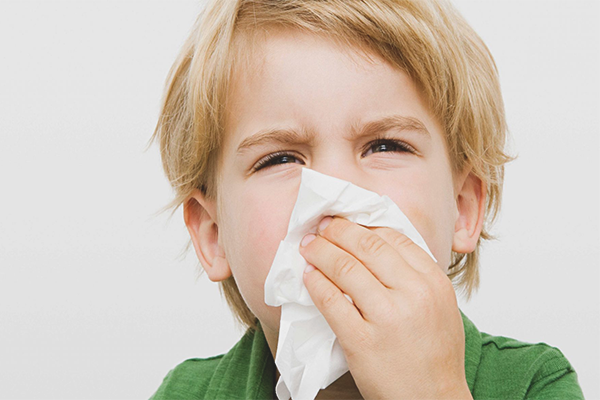
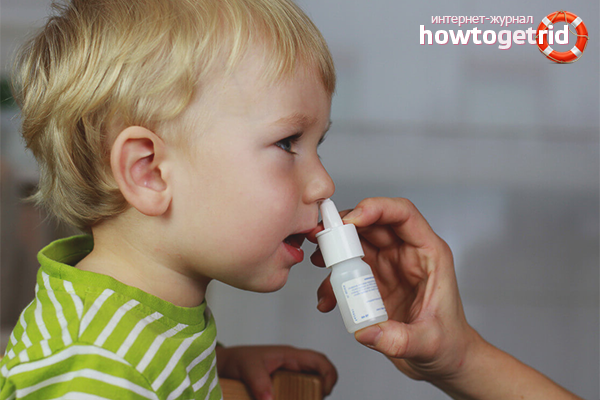

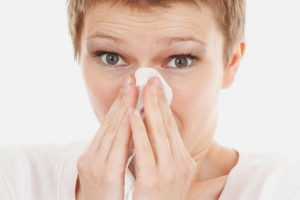
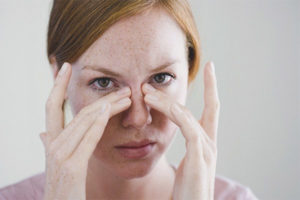
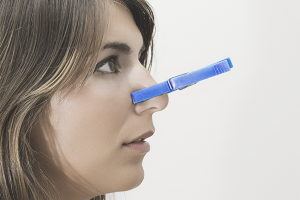

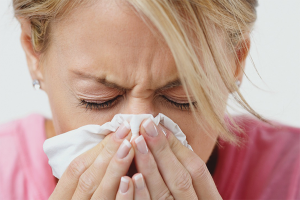
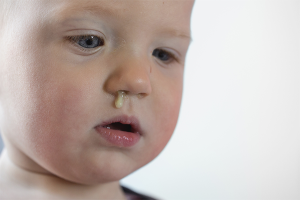
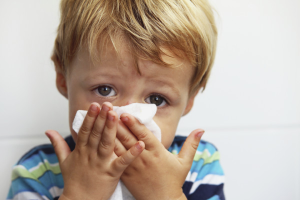
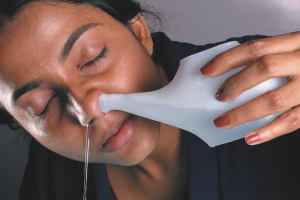
To send